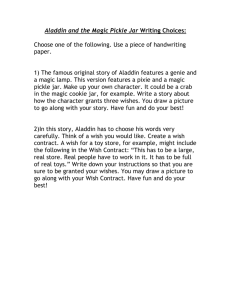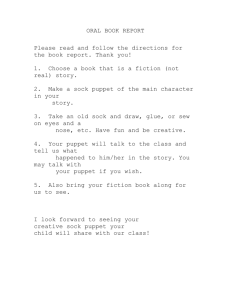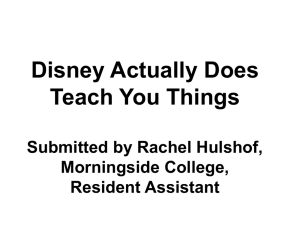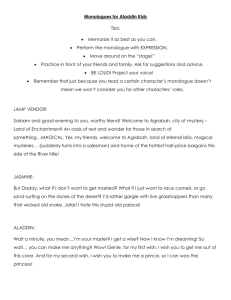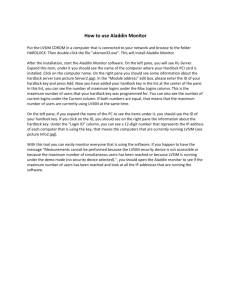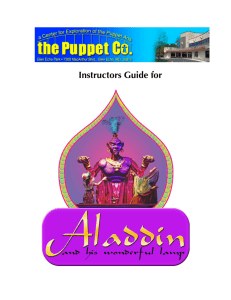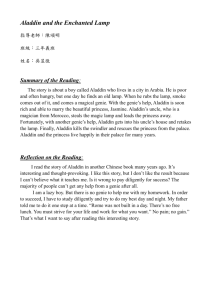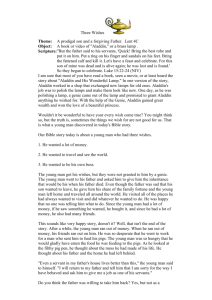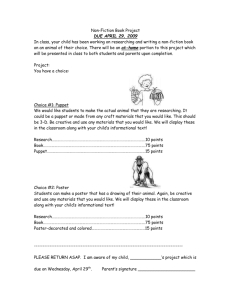Teachers information pack
advertisement
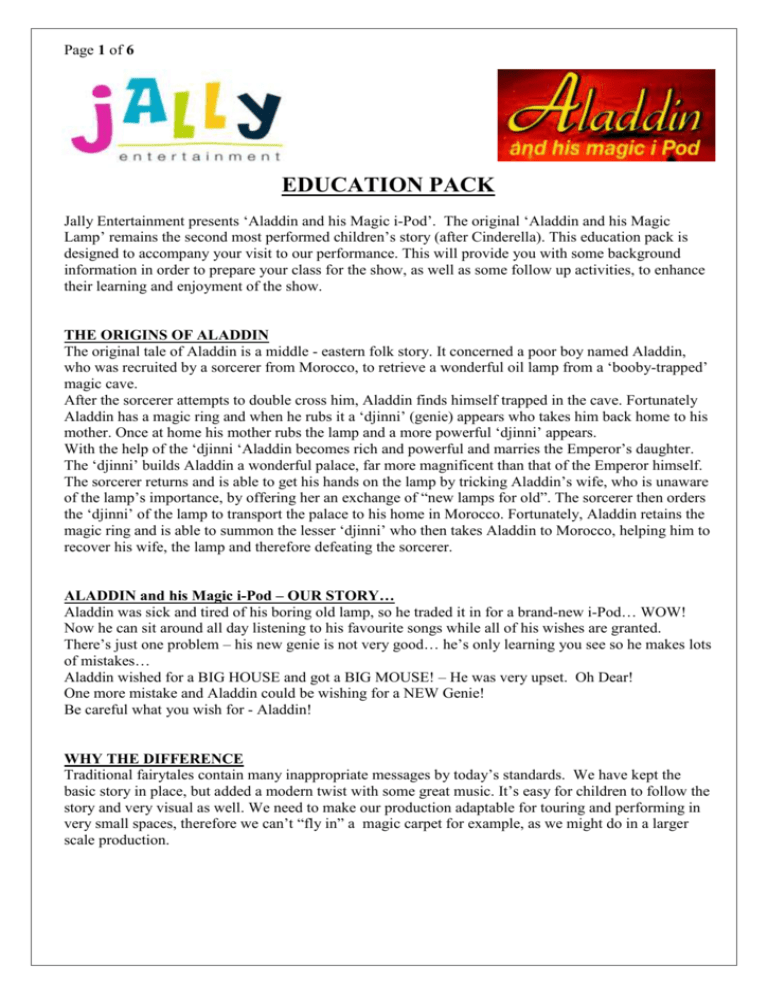
Page 1 of 6 EDUCATION PACK Jally Entertainment presents ‘Aladdin and his Magic i-Pod’. The original ‘Aladdin and his Magic Lamp’ remains the second most performed children’s story (after Cinderella). This education pack is designed to accompany your visit to our performance. This will provide you with some background information in order to prepare your class for the show, as well as some follow up activities, to enhance their learning and enjoyment of the show. THE ORIGINS OF ALADDIN The original tale of Aladdin is a middle - eastern folk story. It concerned a poor boy named Aladdin, who was recruited by a sorcerer from Morocco, to retrieve a wonderful oil lamp from a ‘booby-trapped’ magic cave. After the sorcerer attempts to double cross him, Aladdin finds himself trapped in the cave. Fortunately Aladdin has a magic ring and when he rubs it a ‘djinni’ (genie) appears who takes him back home to his mother. Once at home his mother rubs the lamp and a more powerful ‘djinni’ appears. With the help of the ‘djinni ‘Aladdin becomes rich and powerful and marries the Emperor’s daughter. The ‘djinni’ builds Aladdin a wonderful palace, far more magnificent than that of the Emperor himself. The sorcerer returns and is able to get his hands on the lamp by tricking Aladdin’s wife, who is unaware of the lamp’s importance, by offering her an exchange of “new lamps for old”. The sorcerer then orders the ‘djinni’ of the lamp to transport the palace to his home in Morocco. Fortunately, Aladdin retains the magic ring and is able to summon the lesser ‘djinni’ who then takes Aladdin to Morocco, helping him to recover his wife, the lamp and therefore defeating the sorcerer. ALADDIN and his Magic i-Pod – OUR STORY… Aladdin was sick and tired of his boring old lamp, so he traded it in for a brand-new i-Pod… WOW! Now he can sit around all day listening to his favourite songs while all of his wishes are granted. There’s just one problem – his new genie is not very good… he’s only learning you see so he makes lots of mistakes… Aladdin wished for a BIG HOUSE and got a BIG MOUSE! – He was very upset. Oh Dear! One more mistake and Aladdin could be wishing for a NEW Genie! Be careful what you wish for - Aladdin! WHY THE DIFFERENCE Traditional fairytales contain many inappropriate messages by today’s standards. We have kept the basic story in place, but added a modern twist with some great music. It’s easy for children to follow the story and very visual as well. We need to make our production adaptable for touring and performing in very small spaces, therefore we can’t “fly in” a magic carpet for example, as we might do in a larger scale production. Page 2 of 6 PRE – PERFORMANCE ACTIVITY Q. A. You are going to see a stage play. Can you describe what a stage play is? It’s a form of writing, scripted for acting. Acting is the job of an actor, which is a person in theatre, television, film or any other storytelling medium who tells the story, by portraying a “character”. Q. A. Do you know what an “interactive” performance is? Aladdin and his Magic i-Pod is “interactive”. This means you might be lucky enough to be picked to perform on the stage, with the actors. **If an actor asks for “helpers” please put up your hand, just as you would in the classroom. The actor might choose you to come up on the stage, and help with the show. Q. A. What do actors do to prepare, before they perform in a show? Exercise. Actors need to warm up with exercises before they perform, just as an athlete would warm up before starting a race – the athlete might stretch their legs so they don’t get a cramp in the race. The actor needs to stretch the vocal chords so there is no straining of the voice during the show. A good vocal warm-up sounds like this…..ma ma ma ma ma…me me me me me… mi mi mi mi mi… mo mo mo mo mo….ma me mi mo… ma me mi mo…ma me mi mo…ma me mi mo…aeiou aeiou aeiou aeiou aeiou… red leather, yellow leather, red leather, yellow leather…unique new york, unique new york, unique new york….repeated three or four times through. Actors also stretch their arms and legs before performing physical theatre and musicals. GREED One of the messages ‘Aladdin and his Magic i-Pod’ delivers is, “be careful what you wish for”. Q. A. Why should Aladdin be careful what he wishes for? This is all about greed. There’s nothing wrong with wishing for nice things, but Aladdin doesn’t know when to stop. Greed is taking more than you need or deserve. Give your teacher an example of greed. RESPECT Another message here is respect. Aladdin doesn’t speak very nicely to his friend, the genie. The genie makes lots of mistakes, but he tries his best, he’s only learning. Aladdin gets angry and speaks to him harshly. When your teacher asks you to sit quietly, you follow the request. This shows respect for your teacher. Give your teacher an example of respect. . ACTIVITY Colour-in sheets are provided, please spend some time colouring them in – remember to use lots of bright colours and try to stay within the lines. Page 3 of 6 POST PERFORMANCE ACTIVITIES ACTIVITIES Pretend you are Aladdin. Write a short story, describing your adventures as Aladdin. What are your wishes for the future? How do you feel at the end of the story? Q. A. Many different puppets appear on television and the movies. Can you name any? (Elmo, Agro, Kermit, Bert and Ernie) Students are to sit with their eyes closed. The teacher asks students to think back and recall the performance of ‘Aladdin and his magic i-Pod’. What did they see? What did they hear? Which character did they like the most and why? What is the moral of the story? Make simple masks to represent the characters they have seen in the play. Let the children express themselves by playing out from memory, what they remember from the play. How did Aladdin feel towards the genie? Imagine that you have a magic carpet and it could take you to any place in the world. Where would you like to go? i.e. favourite holiday place/ best friend’s house…. Why do you want to go to this place? Show your class your favourite place on a world map/globe. Draw a picture of your favourite place with you and your magic carpet. If you could have three wishes, what would they be? Why did you choose these three wishes? Draw your three wishes. GEOGRAPHY Aladdin’s homeland is very hot all year round. What are the four seasons called? How are they different from each other? How long does summer last in Australia? What about the temperature in other countries. Is England hot or cold? Is the South Pole hot or cold? Make a list of hot countries. Make a list of cold countries. ART Design a poster to advertise your own show. Page 4 of 6 MAKE YOUR OWN SOCK PUPPET Making a puppet is easy and lots of fun! It’s a good idea to draw your idea on paper first. Look at the story and decide on characters, props and objects that can be made from materials in your classroom. Some suggestions for your puppet could be a duck, dog, snake, dinosaur or an alien…all of which can be brought to life with ‘puppetry’. Think about what you are going to make – ask for some help, if you need it. Try drawing a picture of how your puppet will look, when it is finished, Firstly… you will need a sock, think about what you are making – if it’s a chicken, a white or yellow sock, this will help the audience understand what your puppet is. The sock needs to be large enough to fit loosely over a child’s hand. Selection of materials for your puppet such as – buttons for the eyes – cotton wool for hair – maybe you could ask an adult for an old pair of glasses to make your puppet into a grandma or grandpa. Other items you can search for and use are pipe cleaners, old ribbons, pieces of fabric. Use your imagination to bring your puppet to life. PVA Glue – this is used to stick buttons, cotton wool etc. onto your sock to make it as individual as you are. Page 5 of 6 MAKE YOUR OWN SOCK PUPPET - continued 1. Place your hand in the sock with thumb and fingers working like a mouth. 2. Mark lightly with a marker - areas for mouth, eyes, nose, and ears. Attach your decorations to make eyes, hair and other facial features. Teachers please note - Make eyes with a black permanent marker if puppet is going to be used by small children. Make antlers, horns, or antennas from pipe cleaners. 3. Practice with the puppet in front of the mirror, talk as you open the puppets mouth. Don’t forget to give your puppet a name. Page 6 of 6 MAKE YOUR OWN SOCK PUPPET - continued You could also paint the sock – make sure you ask your teacher or mum/dad/carer to help. You need to do this in a safe area. Put some old newspapers down in case you spill some paint. MOVING THE MOUTH Think about how your mouth moves. Use a mirror to watch yourself talk. Play some music of your favourite song and move your puppets mouth to the lyrics. Make your puppet become more alive by bobbing to the beat or moving his/her head. When you puppet comes to life – remember the following; Puppets should be looking at the audience. Make sure your puppet is “alive” and “in character” before you bring them to the audience. If you are staging a ‘puppet show’ with more than one puppet, make sure that only one puppet speaks at a time. Try getting hold of a large cardboard box which could be your performance space. This will give you something to hide behind as well. You can dress up the box using cloth or paper.
